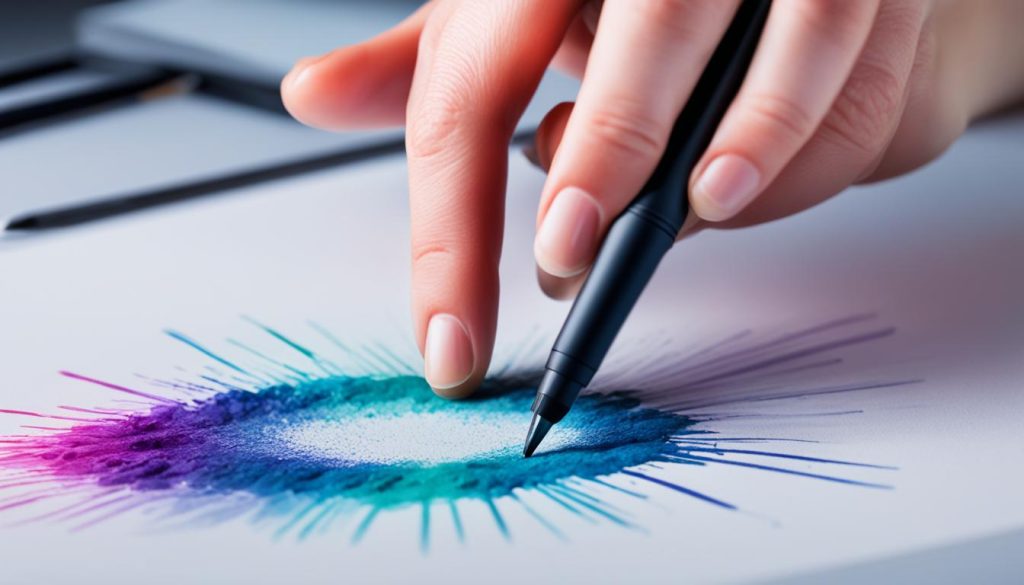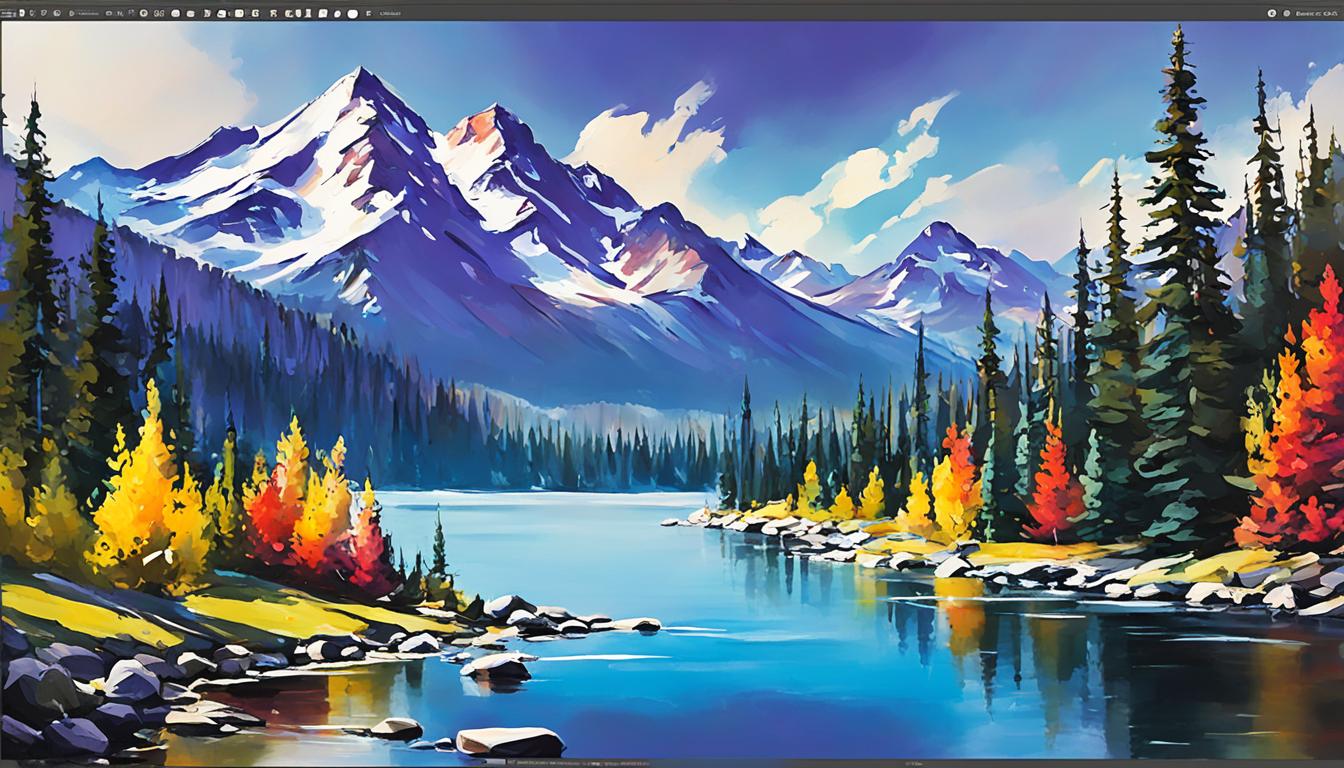Did you know that painters worldwide spend an average of 20-30 hours completing a single art piece? Whether you’re a beginner or an experienced artist, the traditional painting process can be time-consuming and meticulous. But what if there was a way to achieve stunning results in a fraction of the time?
Introducing Speedpaint 2.0, a revolutionary painting tool that allows you to master your art quickly. This versatile and easy-to-use solution simplifies the painting process by providing a base color, intense shading, and highlighting effects in just one coat. Say goodbye to countless layers and lengthy drying times – with Speedpaint 2.0, you can bring your artistic vision to life in record time.
Key Takeaways:
- Speedpaint 2.0 is a one-coat painting solution that saves you time and effort.
- Whether you’re a beginner or a seasoned painter, Speedpaint 2.0 can help you achieve impressive results quickly.
- Simplify the traditional painting process with Speedpaint 2.0’s base color, shading, and highlighting effects in one coat.
- With Speedpaint 2.0, you can bring your artistic vision to life in a fraction of the time.
- Say goodbye to lengthy drying times and hello to stunning artwork with Speedpaint 2.0.
Tip 1: Glazing with Speedpaint
One of the most effective speedpainting techniques is glazing with Speedpaint. Glazing involves applying thin, translucent layers of paint over an already-painted surface. This technique is perfect for adding depth, shading, tinting colors, and creating smooth transitions between different shades.
To achieve beautiful glazing effects with Speedpaint, you’ll need to mix 1 part Speedpaint with 4 parts Speedpaint Medium. This mixture will create a glaze that is easy to work with and provides excellent coverage. This ratio ensures that the glaze is thin enough to let the underlying colors show through while still providing a vibrant tint.
When applying the glaze, use a clean brush and apply it onto the basecoat with feathering and blending motions. This will help create a seamless transition between the glaze and the basecoat, resulting in a more professional and cohesive look.
Another advantage of using Speedpaint for glazing is that Speedpaint Medium can also be used to help smooth out color blends. The Speedpaint Medium is formulated to work seamlessly with Speedpaint, making it easier to achieve smooth transitions between colors and eliminate any visible brushstrokes.
Tip 2: Drybrush over Speedpaint
Another tip for speedpainting is to drybrush over Speedpaint. Drybrushing is a technique that enhances the contrast between shaded areas and raised details, adding texture and a dynamic look to the miniature. It is a great way to bring out the intricate details and make them pop.
To drybrush over Speedpaint, begin by applying a basecoat of your chosen color. Make sure the basecoat is dry before moving to the next step. Then, take a large drybrush and dip only the tips into a lighter color or metallic paint. It’s important to use a minimal amount of paint on the brush to achieve the desired effect.
Next, gently swipe the brush over the raised edges and protruding areas of the miniature. The drybrush should catch the edges, creating highlights and adding depth. Ensure to apply the paint lightly and gradually build up the intensity to avoid overloading the surface. This technique allows you to selectively apply color, creating a weathered or worn effect on the miniature.
Remember, practice makes perfect. Experiment with different brush sizes, colors, and techniques to achieve the desired effect. Drybrushing is a versatile technique that can be used for a variety of effects, from adding highlights to creating a weathered appearance.
Benefits of Drybrushing
Drybrushing offers several benefits when used in speedpainting:
- Enhances the contrast between shaded areas and raised details
- Adds texture and depth to the miniature
- Creates a dynamic and weathered look
- Allows for selective application of color
- Can be used for highlighting and creating worn effects
- Quick and easy technique to learn and master
By adding drybrushing to your speedpainting repertoire, you’ll be able to elevate your miniatures and make them stand out on the tabletop.
Tip 3: Using Speedpaint for Texturing
When it comes to speedpainting techniques, one effective method is using Speedpaint to add a textured appearance to miniatures. This technique can bring your creations to life by adding depth and interest. Here’s how you can do it:
- Start by applying a basecoat of Speedpaint to your miniature. Choose a color that will serve as the foundation for your texture.
- Next, grab a sponge and dip it in another contrasting color of Speedpaint. This color will be used to create the texture.
- Gently stipple the sponge onto the miniature, focusing on the worn edges and areas that would naturally have more texture.
- Continue stippling until you achieve the desired textured effect. Don’t be afraid to experiment with different sponge sizes and angles to create various textures.
- To ensure a harmonious result, consider applying a Speedpaint glaze over the textured areas. This will help unify the texture with the rest of the miniature.
By using Speedpaint for texturing, you can elevate your miniature painting to the next level, adding depth and visual interest to your creations.

Tip 4: Speedpaint Copper Verdigris and Rust Effect
Speedpaint, the versatile painting tool, offers a range of techniques for achieving realistic and aged effects on miniatures. One such technique is creating a copper Verdigris and rust effect, which adds depth and character to metal surfaces.
To start, apply a basecoat of Speedpaint Metallics on the miniature. This will serve as the foundation for the subsequent layers. Next, take a wash of a different color and apply it over the metallic basecoat. This wash will create the beautiful Verdigris effect, mimicking the weathering process of copper over time.
To further enhance the aged appearance, thin down a Warpaints Effect Dry Rust paint. Apply this thinned paint as a wash, focusing on the focal points of the miniature’s metallic areas. This technique will simulate the rust that naturally forms on metal surfaces, adding a realistic touch to your miniatures.
By using Speedpaint to create a copper Verdigris and rust effect, you can transform ordinary miniatures into stunning works of art. With just a few simple steps, you can achieve depth, realism, and an aged appearance that will captivate viewers.
